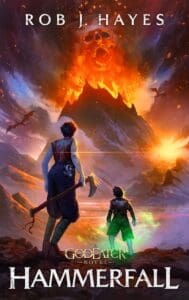
Review:
When I first discovered C.S. Humble’s The Massacre at Yellow Hill, I was giddy. That book mixes a gritty western mythos with vampires, secret societies, and cosmic horror, but more importantly, it does what I come to story for: it gave me new people to love.
Gilbert Ptolemy and his adopted son, Carson; Tabitha Miller and her family; these characters appear fully formed on the page, and they assert their reality with every action, every scrap of dialogue, every sacrifice.
It doesn’t hurt that Humble’s prose alternates between razor sharp observation and passages of lyrical beauty not often found in your average horror novel.
As I read on through the trilogy (A Red Winter in the West and The Light of Black Star), it became clear that there was much more at work there. Through this ever-expanding story, Humble wasn’t just spinning a great yarn. He was building worlds.
The 19th century of Humble’s books may sometimes resemble that historical era, but it is most certainly an alternative history with complex, competing occult organizations, all variety of supernatural entities, a highly regimented Gunfighters Guild, a young hero struggling with his troubling destiny, and a deep system of magic that ties all of these disparate parts together, leading up to a final battle.

I’d been hoodwinked. This wasn’t a horror-western series at all. I was reading an epic fantasy.
Ever since, I’ve been an evangelist for these books, the voice of one crying in the wilderness: Hey, you want to have your heart ripped out? Have I got the books for you.
So, when I heard that Humble was releasing more books in the series, I was understandably excited, and when I learned that they were prequels, I was doubly excited. Why? Because in Humble’s world, there is no safety for anyone, especially those characters we love most. So these prequels offer us the opportunity to spend time with those we’ve loved and lost.
More importantly, they allow Humble to deepen his world building, slow down to investigate the mythology of The Peregrine Estate, the occult organization fighting for the fate of the world. We also get a deeper look at the mechanics and politics of the famed Gunfighters Guild. All of this while we see the pieces shifting slowly into place to bring us to the plot events of the original trilogy. It’s deeply imagined, fascinating stuff.
But none of that is what matters.
These books are pure character work.
The opening volume, To Carry a Body to its Resting Place, follows the early career of the lovable rogue, Ashley Sutliff. In the original trilogy, Sutliff is a kind of Han Solo figure, drawn into the occult drama against his will. He’d much rather be playing cards, though, naturally, under his brash exterior is a loyal heart.
To Carry a Body to its Resting Place rounds out Sutliff’s character to great effect, humanizing him to an almost unbearable degree.
Ashley is drawn home by the news of his father’s impending death, and while there he uncovers family secrets and eventually rides off on what will become his first action for the Peregrine Estate, but these latter details are almost incidental. The heart of this book is a meditation of fathers and sons, what is owed, and how we say goodbye that more to Larry McMurtry than any horror or fantasy writer. It’s an emotionally wrenching read that suddenly hurtles into action.
San Antonio Mission is a much more plot-driven entry, with my favorite character, Gilbert Ptolemy dispatched by the Peregrine Estate to recruit newly freed slaves to join the cause. Ptolemy, a former slave himself, is partnered with the wisecracking Sarah Lockhart and a member of the Gunfighter’s Guild because there’s no guarantee that the former owner of these people will allow them to leave, even in this post-Juneteenth era.
These suspicions turn out to be correct, but nothing could prepare our team for the depth of the horrors that await them at the mission.
San Antonio Mission focuses more on human horrors, while placing them quite explicitly within their historical contexts, allowing Humble to investigate the horrors of U.S. history itself, and its legacy of racist violence. It also offers a cathartic response to those who set themselves up as tyrants. Add in some romance and the delightful new gunslinger, Oliver Maine, and this second volume feels like a much more complete and self-contained entry into the saga.
The final book in the trilogy, The Baroness of the Eastern Seaboard, does a lot to segue into the original storyline, presenting some of the future Big Bads, while also allowing the reader to access the interior world of the Gunfighters Guild. As with the other volumes, these are mostly details. The center of The Baroness of the Eastern Seaboard is the relationship between Sven and Larry, devoted husbands who also happen to be inching perilously close to each other’s ranks within the Guild. Any day now, they will be forced to compete for rank, meaning one of them must die.
The couples’ attempt to petition the Guild for a way around this impossibility leads to quests for each of the lovers, both of them bloody and harrowing. The most explicitly romantic of the three books, Baroness is a love story wrapped in a Peckinpah movie’s violence and propulsive action.
As a reader, all I wanted to do was protect Sven and Larry, but the facts of Humble’s universe leave no one safe, and things get just about as bad as they can get while still leaving our heroes alive to appear later on in the saga.
All in all, The Peregrine Estate Trilogy is a varied and wondrous treasure trove of stories that situate themselves less as straight prequels than as elaborate midrash, glimpses between the scenes of the larger story, illustrating Humble’s knack for not only storytelling and lush prose, but his near magical penchant for character building. It is a necessary addition to what has become a vast saga. Here’s hoping there’s more to come.
The Peregrine Estate Trilogy will be available in September of 2025.








Leave a Reply